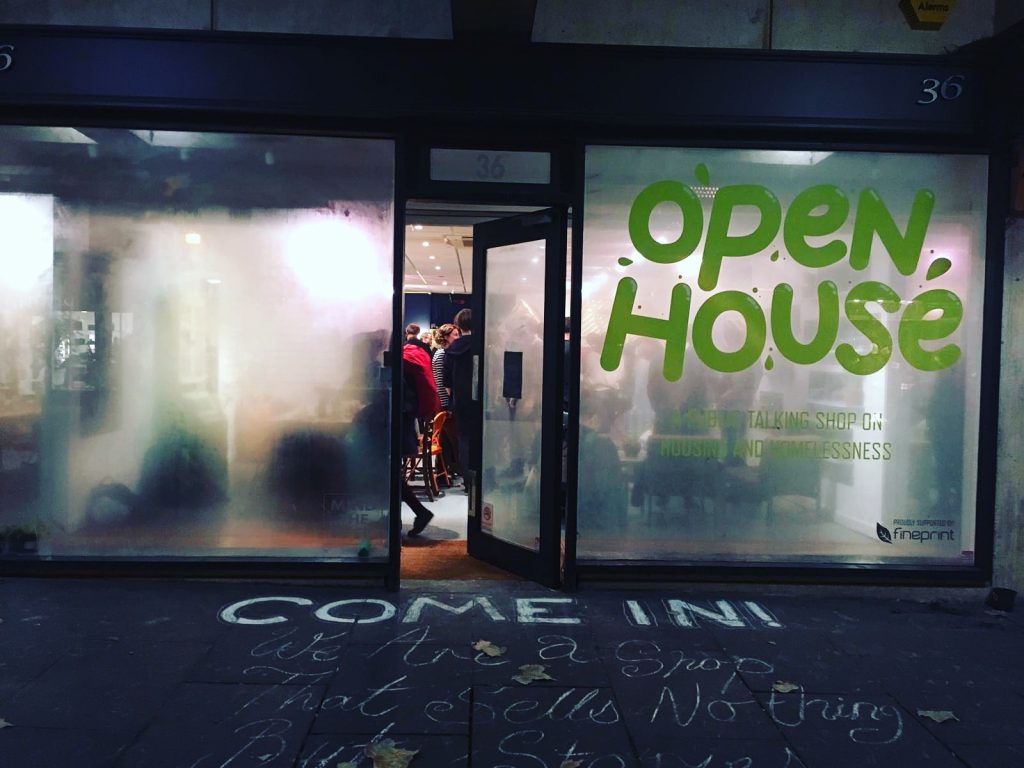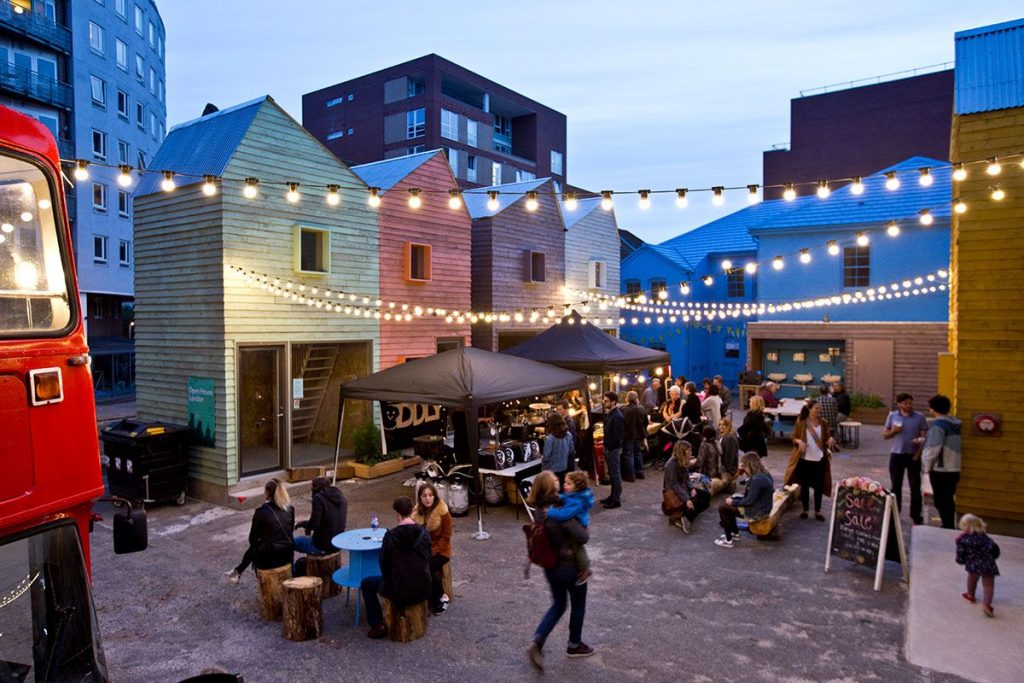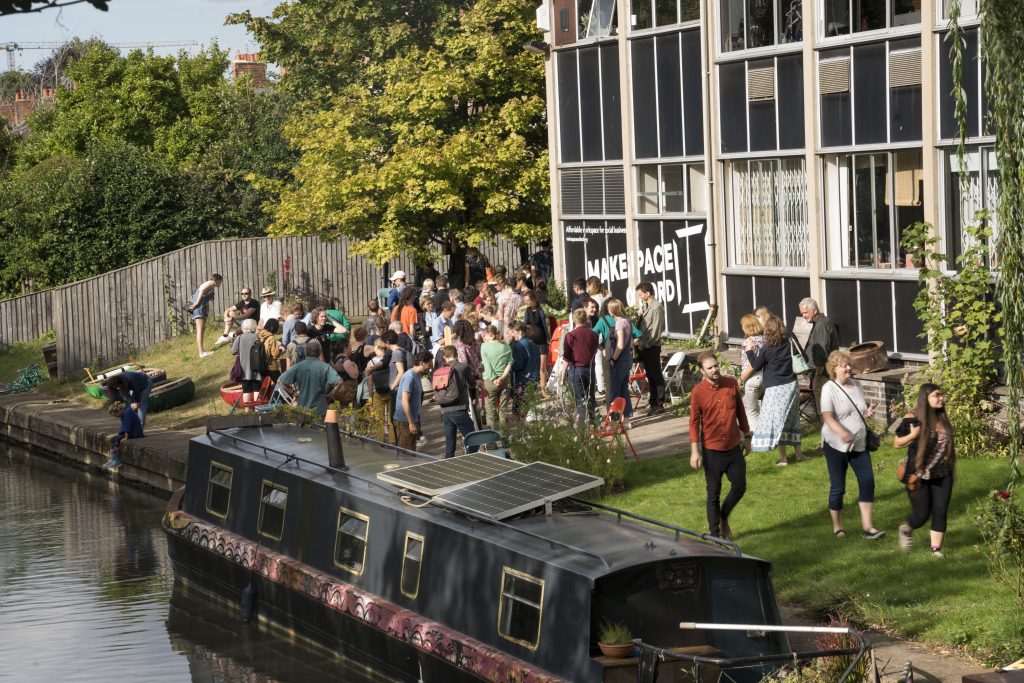Meanwhile projects are here to stay and it’s up to us as architects and designers to harness and create impact from meanwhile use in our towns and cities.
At Transition by Design (T/D) we’ve been at the forefront of thinking, doing and collaborating on temporary interventions for some time. We’ve used meanwhile projects as an impactful tool for discussion and action on housing and homelessness, as well as developing incubation spaces and thought leadership around meanwhile use. Building on this knowledge, we are supporting the development of meanwhile spaces across Oxfordshire as part of an 18 month grant funded programme with Makespace Oxford. Throughout our work, we’ve recognised that projects of this nature can create fertile ground for innovation, inclusion and civic participation, and despite their seemingly temporary nature, meanwhile projects are not going anywhere any time soon…
In these two blog posts, we will be exploring why we believe meanwhile architecture is here to stay and how to do it well. Here we will be discussing why we believe meanwhile isn’t going anywhere and what this means for us as practitioners. In part two, we will be sharing insight on doing meanwhile well from our experience in running and collaborating on projects. Throughout, we will be sharing examples that have inspired us and that show what is possible when temporary projects are done well. Meanwhile projects have inherent constraints, but also huge untapped potential and we’re excited about what lies ahead as we as architects and designers get better at doing meanwhile architecture well.
The rise of meanwhile
Meanwhile projects take many forms, but at their heart they are projects making use of existing spaces or land that are temporarily available. The rise of the meanwhile space has been going on for some time, and there is a growing list of communities, charities, activists and businesses that are seeing repurposing empty and underused spaces as a tool for transformation. T/D knows a thing or two about effective use of temporary spaces, and as architects and designers we believe our role is key – bringing our skills, creativity and deep knowledge of people and planning to this emerging field of practice, where effective collaboration is key.
The story behind the gaining of momentum of temporary space use is not an all together rosy one. Trends in shopping online, urban space use and the increasingly generic nature of towns and cities have been leading us on a path towards the decline of highstreets for some time, with vacant shops already endemic ahead of the impacts of the Covid-19 pandemic and Brexit.
It was in this context that projects like Open House Oxford were able to thrive, where T/D created a ‘public talking shop’ for a year in a disused shop in Oxford city centre, welcoming 5,400 people through its doors to attend the 159 events on the themes of housing an homelessness across the course of a year. For some time now, meanwhile projects have been inhabiting declining town centre spaces whilst giving licence to re-imagine what they could become. Take Croydon Urban Room, a space that invites citizens to step in and participate in the future of their area, or the Every One Every Day shops, disused former retail units which rather than selling anything simply ask the question ‘what amazing neighbourhood projects can we start if we all work together?’. This imagination has not been constrained by bricks and mortar, with interventions like the Cricklewood Town Square, a civic space hosted on the back of a bicycle, proving through creative temporary interventions that it’s not the appetite for gathering and being together in urban space that’s lacking, it may just be the spaces available.

Another strand of meanwhile use that has been steadily building steam since pre-pandemic are incubator projects in temporarily available commercial space. Projects such as Blue House Yard, Makespace Oxford and Everyone’s Warehouse have been using temporary locations such as empty garage sites, warehouses and car parks to help people reimagine the face of civic space and the highstreet; developing opportunities where architects and designers can come together with purpose-driven organisations and communities to thrive and be an active part of shaping the future of their community together.
Stalled developments and projects put on hold due to uncertainties brought forward by the pandemic and Brexit have led to even more buildings sitting empty, with huge untapped potential. Even before the pandemic, there were an estimated 11,000 commercial properties that have been vacant for over two years in London alone, and this number is expected to be much higher today.
Empty buildings fail almost everyone except speculative interests, but this doesn’t have to be the case. There are numerous proven benefits to occupation that create a win-win for landlords and potential occupants as well as surrounding communities, if we do it right. The conditions that foster mutually beneficial temporary use are increasingly well understood both through good existing examples and in emerging policy too; the time has never been better for meanwhile projects to emerge. For landlords the benefits are primarily savings on empty building rates for spaces that are not left empty, and with temporary tenants willing to accept buildings without the renovations that a more permanent client might expect, it can offer an attractive solution. Given the right conditions, there is no shortage of budding entrepreneurs, social innovators and community projects to occupy spaces within urban centres temporarily, and it’s within our role as built environment professionals to enable, support and design these opportunities alongside building appetite amongst the local community.
Now that lockdowns are a thing of the past, people want to see change. People want to re-engage with society and feel connected again, and with so many nascent ideas prototyped by communities during the pandemic, there is fertile ground for trialling new small businesses, community initiatives and different ways of being together in public. The very nature of temporary use brings a certain feeling to spaces – a feeling of something yet to be fully defined, a work in progress that is only developed fully by being inhabited, and this is where architects and designers come in.

Why temporary use isn’t going anywhere
Current national and local government policies are likely to firm up the conditions that make temporary use favourable to landlords as well as potential users of temporarily available space. For example the government’s Levelling Up Bill creates opportunities for local authorities to trigger auctions to compel landlords to fill up empty retail space. This puts pressure on landlords to find tenants, and in turn makes temporary contracts appear more attractive. This is coupled with recent amendments to the process of changing the intended Class Use of a building, making it easier in some instances to change from one purpose to another without needing to apply for planning permission.
Financial incentives are also in place, with some local governments reducing business rates to tempt businesses back to the highstreet, and grant funding for larger strategic schemes to bounce back after the pandemic. Meanwhile in Oxfordshire was made possible through the government’s Getting Building Fund, and pots of money for arts and culture organisations that need somewhere to call home are more favourable now than they have been in some time.
While large-scale developments are the juggernauts of the architectural world, temporary use can be nimble and, with the right toolkit in place, quickly deployed. In the face of ongoing uncertainty for large developments due to Brexit, Covid-19 and increasing material costs and supply delays, the meanwhile sector is continuing to grow and even thrive. During the time periods in which large scale developments are decided on, funded and designed, buildings have often sat empty or underused for a number of years and we are seeing this in cities all over the UK. During this time, a meanwhile project can find a meaningful home onsite, at the same time as acting as passive surveillance over otherwise forgotten spaces. The value of avoiding temporary wastelands whilst freeholders decide what to do next with their land is both starting to be enacted in policy and planning regulations, and to be taken increasingly seriously by developers, funders and communities alike. All of these factors combined mean that conditions in favour of meanwhile use don’t appear to be going anywhere anytime soon.

Towards a field of practise
Despite these factors acting in favour of meanwhile, and the foundational knowledge and recent practice developed by inspiring architects and designers, there are still questions that need to be answered. Defining the know-how needed, and specific role of temporary architecture as part of the wider toolbox for creating vibrant, inclusive places to live, work and play is an ongoing process. Not least the questions of how buildings or spaces with varying stages of retrofitting needs can be used effectively for projects. For example, is it worth retrofitting a space on a shoestring budget only for a short time? How do we balance the sometimes intangible outcomes created against very real project costs? And how do you define value and worth in the context of the temporary anyway?
Similarly, we need to understand what the platforms and vehicles for supporting temporary development should look like. Organisations like Meanwhile Space and Makespace Oxford, and programmes like Meanwhile in Oxfordshire are starting to answer that question, but there is still a need to better understand how organisations can mediate and support users to find, fit-out and enter into tenancy agreements for temporary spaces, and how funding can be used to incubate the types of projects we need more of in our towns and cities for which a revenue model may not exist.
These are worthwhile questions to explore and develop, and there is a huge open space for organisations, architects and designers to step in and take part in a conversation around doing meanwhile well. Join us for [LINK:part two, doing meanwhile well], where we will share more specific insights from our practice, supporting anyone with an interest in meanwhile architecture to better understand what it takes to make effective use of the opportunities that meanwhile use presents.
Copywriter: Tim Warin. Tim Warin is a writer, researcher and urbanist with a focus on community and participation @T_Warin

